Fez captivates players through its innovative puzzle design, vibrant visual style, and engaging narrative techniques. The game’s perspective-shifting mechanic enhances exploration and critical thinking. Its pixelated aesthetics create an immersive environment, while environmental storytelling and non-linear progression deepen player engagement. Regional perceptions further influence how players connect with these elements, showcasing the game’s unique attributes across cultures.
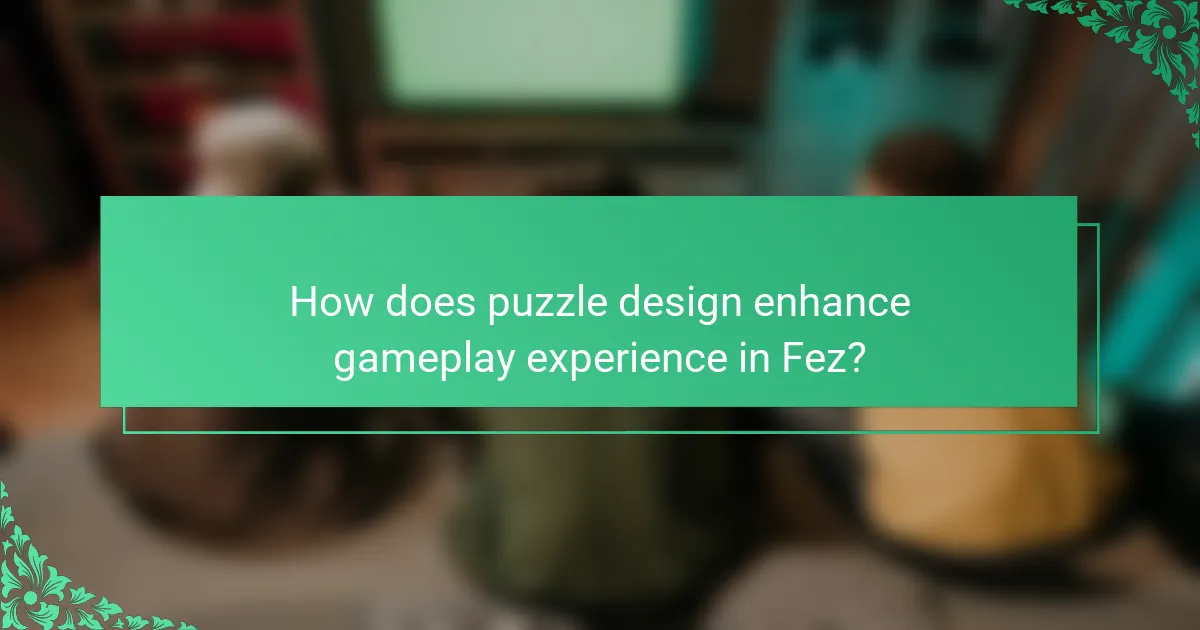
How does puzzle design enhance gameplay experience in Fez?
Puzzle design in Fez enhances gameplay experience by fostering exploration and critical thinking. The game’s unique perspective-shifting mechanic allows players to view the world in new dimensions, creating a sense of discovery. This design encourages players to engage deeply with the environment, solving puzzles that integrate seamlessly with the narrative and visual style. Additionally, the puzzles often require players to connect visual cues with spatial reasoning, enhancing cognitive engagement and satisfaction upon completion. Overall, Fez’s puzzle design significantly enriches the player’s journey through its intricate world.
What are the core principles of puzzle design used in Fez?
The core principles of puzzle design in Fez focus on spatial awareness, visual language, and player engagement. The game emphasizes non-linear exploration, encouraging players to think creatively and observe their environment closely.
Key principles include:
1. **Layered Complexity** – Puzzles build upon each other, introducing new mechanics gradually.
2. **Environmental Storytelling** – Clues are integrated into the world, requiring players to interact with the environment.
3. **Perspective Shifts** – The 2D/3D mechanic alters player perception, adding depth to puzzle-solving.
4. **Player Agency** – Players have the freedom to approach puzzles in various ways, fostering a sense of ownership.
These elements create a rich and immersive experience, making puzzle-solving a central aspect of gameplay.
Which types of puzzles are most prevalent in Fez?
Fez features a variety of puzzles, primarily focusing on spatial reasoning, platforming challenges, and logic-based tasks. These puzzles often require players to manipulate the game’s 2D and 3D perspectives, creating a unique gameplay experience. Additionally, players encounter environmental puzzles that integrate narrative elements and visual style, enhancing immersion. The diversity of puzzle types contributes to the game’s overall complexity and engagement.
How do puzzles evolve throughout the game?
Puzzles in Fez evolve through increasing complexity and layered mechanics. Initially, players encounter simple spatial challenges, gradually introducing more intricate elements like perspective shifts and environmental clues. This progression enhances engagement and deepens the narrative experience. Unique attributes, such as the use of a 2D-3D transition, create a distinct puzzle-solving dynamic. As players advance, rare attributes like cryptographic elements and hidden secrets further enrich the gameplay, making each puzzle a multifaceted challenge that reflects the game’s overarching themes.
What role does player feedback play in puzzle difficulty?
Player feedback is crucial in shaping puzzle difficulty in “Fez.” It informs designers about player challenges, enhancing engagement. By analyzing feedback, developers can adjust puzzle complexity to maintain a balance between challenge and enjoyment. This iterative process ensures puzzles remain accessible while still providing a sense of accomplishment. Additionally, player insights can lead to unique attributes in puzzle design, such as unexpected solutions or innovative mechanics that players discover.
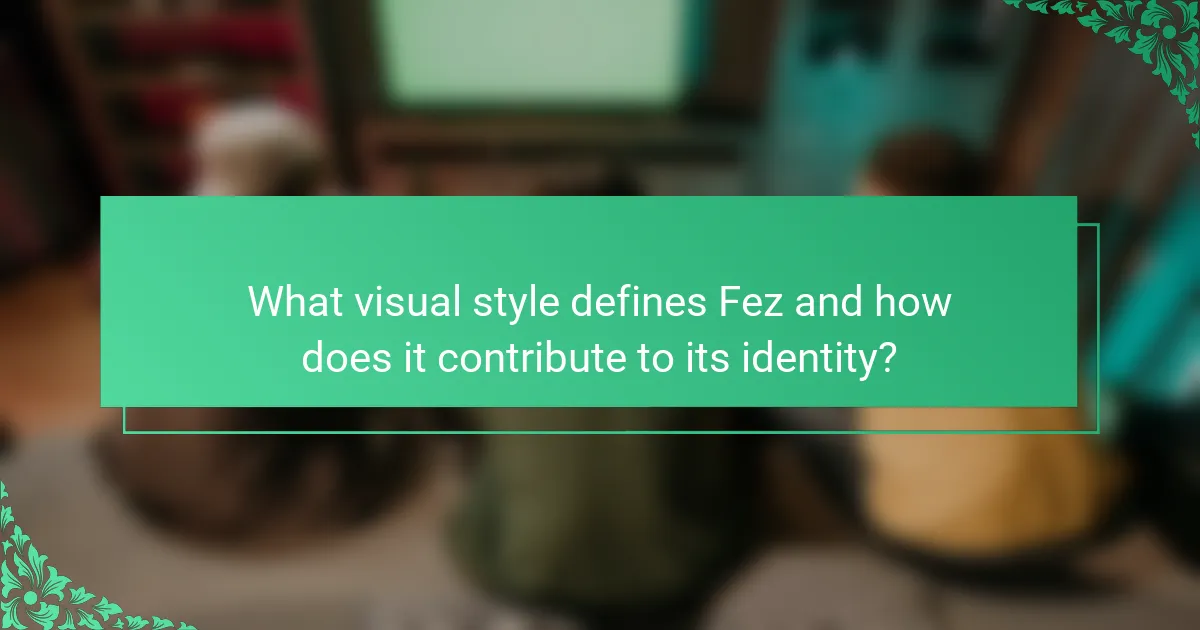
What visual style defines Fez and how does it contribute to its identity?
Fez’s visual style is defined by its vibrant, pixelated aesthetics and unique isometric perspective. This distinctive approach enhances the game’s identity by creating an immersive, engaging environment that invites exploration. The use of bright colors and geometric shapes contributes to a whimsical atmosphere, reflecting the game’s puzzle-oriented nature. Additionally, the visual style complements the narrative techniques, emphasizing themes of discovery and transformation.
How does color theory impact the visual experience in Fez?
Color theory significantly enhances the visual experience in Fez by using vibrant palettes to evoke emotions and guide player navigation. The game’s color choices create distinct atmospheres, influencing how players perceive environments and puzzles. For example, warm colors signify warmth and safety, while cooler tones may indicate danger or mystery. This strategic use of color not only enriches the aesthetic but also aligns with the narrative, reinforcing themes and player engagement.
Which artistic influences shape the game’s aesthetic?
Fez’s aesthetic is shaped by influences from 8-bit and 16-bit video games, pixel art, and the works of artists like M.C. Escher. The game’s vibrant color palette and geometric designs reflect a blend of nostalgia and modernism. Additionally, the incorporation of exploration and puzzle-solving elements draws inspiration from classic adventure games. These artistic choices create a unique visual style that enhances the gameplay experience.
How does the 2D/3D perspective shift affect player engagement?
The 2D/3D perspective shift in Fez significantly enhances player engagement by creating a dynamic puzzle-solving experience. This mechanic encourages exploration and rewards curiosity, as players must think creatively to navigate the game’s world. The unique attribute of shifting perspectives allows players to view the environment in new ways, revealing hidden paths and solutions. As a result, this design fosters a deeper connection to the game’s narrative and visual style, making the gameplay more immersive and stimulating.
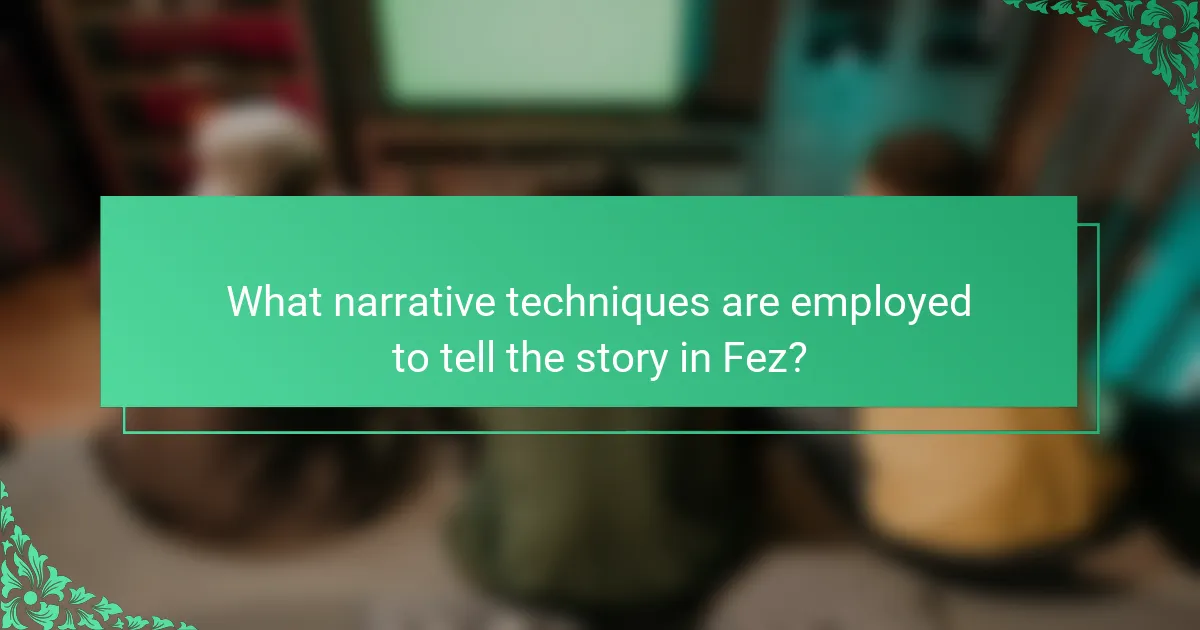
What narrative techniques are employed to tell the story in Fez?
Fez employs various narrative techniques, including environmental storytelling, non-linear progression, and visual symbolism. These methods enhance player immersion and engagement. Environmental storytelling allows players to piece together the lore through exploration. Non-linear progression offers multiple paths, fostering a sense of discovery. Visual symbolism enriches the narrative, with colors and shapes conveying deeper meanings. Together, these techniques create a unique storytelling experience in Fez.
How does the absence of dialogue influence player interpretation?
The absence of dialogue in Fez encourages players to interpret the narrative and puzzles through visual cues and environmental storytelling. This design choice fosters a deeper engagement with the game world. Players rely on their observations and interactions, leading to unique interpretations based on personal experiences. The reliance on symbols and imagery enhances the puzzle-solving aspect, as players must decipher meanings without explicit guidance. This approach cultivates a sense of discovery and individual interpretation, making each playthrough distinct.
What symbolism is present in the narrative structure of Fez?
Fez employs symbolism through its use of geometric shapes, color schemes, and layered storytelling. Geometric shapes represent the puzzle’s complexity and interconnectedness. The vibrant colors symbolize the emotional journey of the protagonist. Layered storytelling reflects the themes of discovery and perspective shifts, enriching the player’s experience. These elements work together to create a deeper narrative that resonates with players, enhancing engagement and interpretation.
How does environmental storytelling enhance the gameplay experience?
Environmental storytelling enhances gameplay by immersing players in the world of Fez through its intricate puzzle design and visual style. The game utilizes environmental cues to convey narrative elements, allowing players to piece together the story without explicit dialogue. This approach encourages exploration and rewards curiosity, creating a deeper emotional connection to the game world. Unique visual aesthetics, such as the vibrant pixel art, complement the storytelling, making the environment a character in itself. As a result, players experience a more engaging and interactive narrative, enhancing overall gameplay satisfaction.
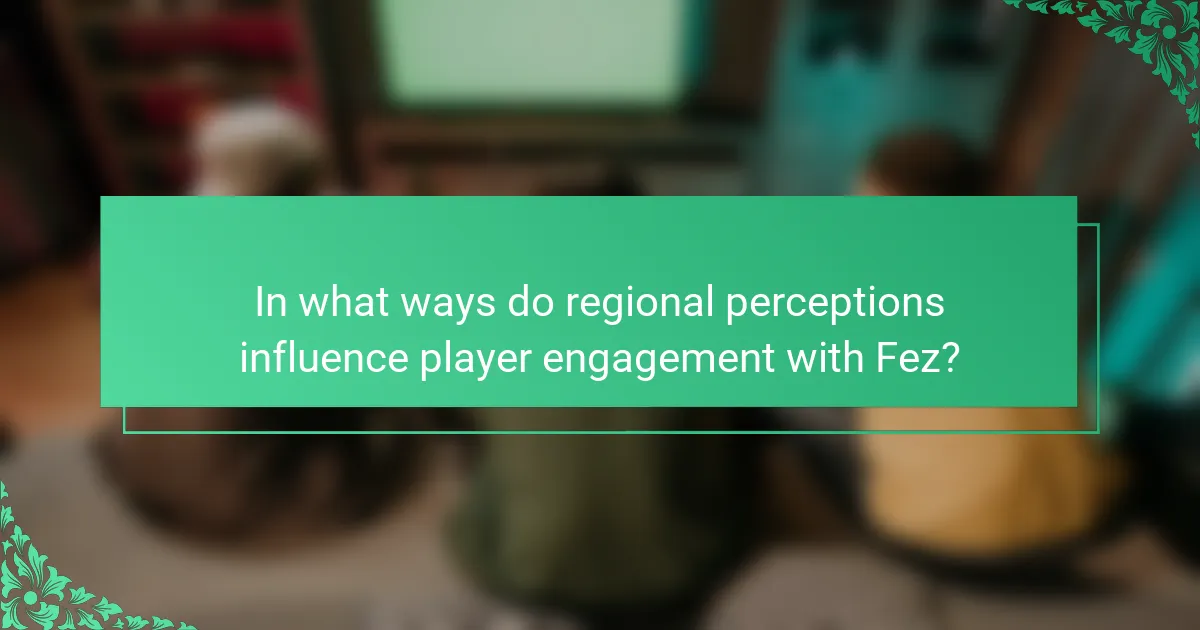
In what ways do regional perceptions influence player engagement with Fez?
Regional perceptions significantly influence player engagement with Fez by shaping cultural interpretations and gameplay experiences. Different regions may emphasize various aspects of the game’s puzzle design, visual style, and narrative techniques, impacting how players relate to the content. For instance, players from cultures that value exploration may engage more deeply with the game’s open-world design, while those with a preference for structured narratives might focus on the storyline. Furthermore, visual styles resonate differently based on local artistic traditions, affecting players’ aesthetic appreciation. These factors create diverse engagement levels, highlighting the unique attributes of Fez in various cultural contexts.
How do cultural differences affect puzzle-solving approaches?
Cultural differences significantly influence puzzle-solving approaches in Fez. Various cultures exhibit distinct problem-solving styles, which can affect how players engage with the game’s puzzles.
For example, Eastern cultures often emphasize holistic thinking, leading players to consider the overall context of puzzles. In contrast, Western cultures may focus on analytical, step-by-step methods. This diversity in thought processes can shape player interactions with the game’s visual style and narrative techniques, enhancing the overall experience.
Additionally, cultural backgrounds can affect players’ interpretations of visual cues and narrative elements, further enriching the puzzle-solving experience. Understanding these differences can help game designers create more inclusive and engaging puzzles that resonate with a global audience.
What are the common challenges faced by players in different regions?
Players in different regions face challenges related to cultural differences, accessibility, and varying levels of game literacy. Cultural differences can affect puzzle design comprehension, leading to frustration. Accessibility issues may arise from language barriers or technological limitations. Additionally, varying levels of game literacy can impact players’ ability to engage with complex narratives and mechanics.
How does community feedback shape updates and expansions of Fez?
Community feedback significantly influences updates and expansions of Fez by guiding design decisions and enhancing player engagement. Player insights shape puzzle complexity, visual aesthetics, and narrative depth. This iterative process fosters a more immersive experience, ensuring that updates resonate with the audience. For instance, feedback may highlight areas where puzzles could be more intuitive or where visual elements need refinement. As a result, the development team can prioritize changes that align with player expectations, ultimately enriching the game’s overall quality.
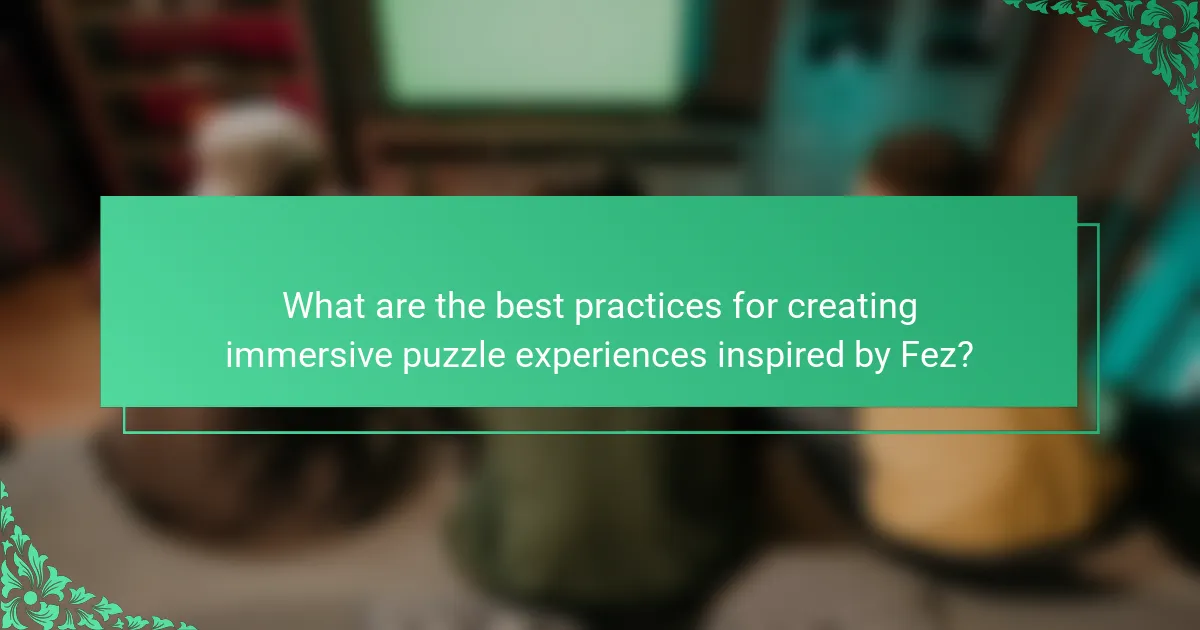
What are the best practices for creating immersive puzzle experiences inspired by Fez?
To create immersive puzzle experiences inspired by Fez, focus on innovative design, engaging visuals, and layered narratives.
Incorporate spatial puzzles that require players to think in multiple dimensions. Use vibrant, pixelated art styles that evoke nostalgia while enhancing the gameplay experience. Develop a narrative that unfolds gradually, encouraging exploration and discovery.
Integrate unique gameplay mechanics, such as perspective shifts, to challenge players’ perceptions. Include environmental storytelling to deepen immersion, allowing players to piece together the narrative through their interactions.
Lastly, encourage community engagement by providing tools for players to create and share their own puzzles, fostering a vibrant ecosystem around the game.
Which design strategies can enhance player satisfaction?
Effective design strategies for enhancing player satisfaction in “Fez” include intricate puzzle design, a unique visual style, and engaging narrative techniques. These elements create a cohesive experience that keeps players invested.
Puzzle design in “Fez” emphasizes exploration and discovery. The puzzles are cleverly integrated into the environment, encouraging players to think critically and interact with the game world. This fosters a sense of achievement upon solving challenges.
The visual style of “Fez” employs vibrant colors and a distinctive 2D/3D perspective shift. This aesthetic not only captivates players but also aids in puzzle-solving by providing visual cues that enhance gameplay immersion.
Narrative techniques in “Fez” utilize a minimalist approach, allowing players to interpret the story at their own pace. This open-ended narrative fosters emotional engagement, making players feel more connected to the game.
By combining these strategies, “Fez” effectively enhances player satisfaction through a rich and rewarding gameplay experience.
What common mistakes should developers avoid when designing puzzles?
Developers should avoid common mistakes like overcomplicating puzzles, neglecting player feedback, and failing to establish clear objectives. These pitfalls can lead to frustration and disengagement.
A well-designed puzzle should balance challenge and accessibility. Developers must ensure that puzzles align with the game’s narrative and visual style, enhancing player immersion. Additionally, testing puzzles with diverse players can reveal flaws and improve design.
How can narrative elements be integrated effectively in puzzle design?
Integrating narrative elements in puzzle design enhances player engagement and immersion. Effective strategies include embedding storylines within puzzles, using environmental storytelling, and creating character-driven narratives that unfold as players progress. These techniques deepen the player’s emotional connection and enrich the overall gaming experience.


